GNSS-R-Based Snow Water Equivalent Estimation with Empirical Modeling and Enhanced SNR-Based Snow Depth Estimation
Abstract
:1. Introduction
2. Methods
2.1. Fusion of Multi-Satellites Snow Depth Estimations
2.2. SWE Empirical Model
2.2.1. Data Preprocessing
2.2.2. Empirical Modeling
2.3. Algorithm of SNR-Based SWE Estimation
- (a)
- Input GNSS observation files and navigation files in a snow season;
- (b)
- Calculate the satellite elevation angle and extract GNSS SNR observations within 5° to 25°;
- (c)
- Select SNR sequences with a clear periodical oscillating pattern;
- (d)
- Perform the Lomb-Scargle spectral analysis for the sequences of “sinθ-SNR”;
- (e)
- Calculate the antenna height and snow depth by Equation (2) and (3), respectively;
- (f)
- Select the calculating results with a PSD peak larger than 0.1;
- (g)
- Fuse the multi-satellite snow depth estimations for each day by Equation (7);
- (h)
- If the maximum of the daily snow depth is larger than 40.3 cm in the snow season:
- (h.1)
- Calculate the snow depth htm corresponding to the maximum SWE, and divide the snow depth into three sequences (Paccum, Ptran and Pmelt) by the maximum snow depth and the snow depth htm;
- (h.2)
- Convert those three sequences of snow depth into the SWE sequence by the second equation in Equation (17).
- (i)
- If the maximum snow depth is smaller than 40.3 cm in the snow season:
- (i.1)
- Divide the snow depth into two sequences (Paccum and Pmelt) by the maximum snow depth;
- (i.2)
- Convert those two sequences of snow depth into an SWE sequence by the first equation in Equation (17).
3. Data
4. Experimental Results
4.1. Validation of SWE Empirical model
4.2. Results with Data Collected in Hartbin, China
4.3. Results with Data Collected at RN86, U.S.
5. Discussion
6. Conclusions
Author Contributions
Funding
Conflicts of Interest
References
- Kinar, N.J.; Pomeroy, J.W. Measurement of the physical properties of the snowpack. Rev. Geophys. 2015, 53, 481–544. [Google Scholar] [CrossRef]
- Yu, K.; Rizos, C.; Dempster, A. GNSS-Based Model-Free Sea Surface Height Estimation in Unknown Sea State Scenarios. IEEE J. Sel. Top. Appl. Earth Obs. Remote Sens. 2013, 7, 1424–1435. [Google Scholar] [CrossRef]
- Small, E.E.; Larson, K.M.; Braun, J.J. Sensing vegetation growth with reflected GPS signals. Geophys. Res. Lett. 2010, 37, 1–12. [Google Scholar] [CrossRef]
- Katzberg, S.; Torres, O.; Grant, M.; Masters, D. Utilizing calibrated GPS reflected signals to estimate soil reflectivity and dielectric constant: Results from SMEX02. Remote Sens. Environ. 2006, 100, 17–28. [Google Scholar] [CrossRef] [Green Version]
- McCreight, J.L.; Small, E.E.; Larson, K.M. Snow depth, density, and SWE estimates derived from GPS reflection data: Validation in the western US. Water Resour. Res. 2014, 50, 6892–6909. [Google Scholar] [CrossRef]
- Jacobson, M. Inferring Snow Water Equivalent for a Snow-Covered Ground Reflector Using GPS Multipath Signals. Remote Sens. 2010, 2, 2426–2441. [Google Scholar] [CrossRef] [Green Version]
- Jacobson, M. Snow Water Equivalent Estimation for a Snow-Covered Prairie Grass Field by GPS Interferometric Reflectometry. Positioning 2012, 3, 31–41. [Google Scholar] [CrossRef] [Green Version]
- Rodriguez-Alvarez, N.; Aguasca, A.; Valencia, E.; Bosch-Lluis, X.; Camps, A.; Ramos-Perez, I.; Park, H.; Vall-Llossera, M. Snow Thickness Monitoring Using GNSS Measurements. IEEE Geosci. Remote Sens. Lett. 2012, 9, 1109–1113. [Google Scholar] [CrossRef]
- Henkel, P.; Koch, F.; Appel, F.; Bach, H.; Prasch, M.; Schmid, L.; Schweizer, J.; Mauser, W. Snow Water Equivalent of Dry Snow Derived From GNSS Carrier Phases. IEEE Trans. Geosci. Remote Sens. 2018, 56, 3561–3572. [Google Scholar] [CrossRef] [Green Version]
- Steiner, L.; Meindl, M.; Fierz, C.; Marty, C.; Geiger, A. Monitoring snow water equivalent using low-cost GPS antennas buried underneath a snowpack. In Proceedings of the 2019 13th European Conference on Antennas and Propagation (EuCAP), Krakow, Poland, 31 March–5 April 2019. [Google Scholar]
- Larson, K.M.; Gutmann, E.D.; Zavorotny, V.U.; Braun, J.J.; Williams, M.W.; Nievinski, F.G. Can we measure snow depth with GPS receivers? Geophys. Res. Lett. 2009, 36, L17502. [Google Scholar] [CrossRef] [Green Version]
- Ozeki, M.; Heki, K. GPS snow depth meter with geometry-free linear combinations of carrier phases. J. Geod. 2012, 86, 209–219. [Google Scholar] [CrossRef] [Green Version]
- Yu, K.; Ban, W.; Zhang, X.; Yu, X. Snow Depth Estimation Based on Multipath Phase Combination of GPS Triple-Frequency Signals. IEEE Trans. Geosci. Remote Sens. 2015, 53, 5100–5109. [Google Scholar] [CrossRef]
- Yu, K.; Li, Y.; Chang, X. Snow Depth Estimation Based on Combination of Pseudorange and Carrier Phase of GNSS Dual-Frequency Signals. IEEE Trans. Geosci. Remote Sens. 2018, 57, 1817–1828. [Google Scholar] [CrossRef]
- Li, Y.; Chang, X.; Yu, K.; Jin, T.; Li, J. Estimation of snow depth using pseudorange and carrier phase observations of GNSS single-frequency signal. GPS Solut. 2019, 23, 118. [Google Scholar] [CrossRef]
- McCreight, J.L.; Small, E.E. Modeling bulk density and snow water equivalent using daily snow depth observations. Cryosphere 2014, 8, 521–536. [Google Scholar] [CrossRef] [Green Version]
- Bilich, A.; Larson, K.M. Mapping the GPS multipath environment using the signal-to-noise ratio (SNR). Radio Sci. 2007, 42, 1–16. [Google Scholar] [CrossRef]
- Serreze, M.C.; Clark, M.P.; Armstrong, R.L.; McGinnis, D.A.; Pulwarty, R.S. Characteristics of the western United States snowpack from snowpack telemetry (SNOTEL) data. Water Resour. Res. 1999, 35, 2145–2160. [Google Scholar] [CrossRef] [Green Version]
- Dressler, K.A.; Fassnacht, S.R.; Bales, R.C. A Comparison of Snow Telemetry and Snow Course Measurements in the Colorado River Basin. J. Hydrometeorol. 2006, 7, 705–712. [Google Scholar] [CrossRef]
- Nievinski, F.G.; Larson, K.M. Inverse Modeling of GPS Multipath for Snow Depth Estimation—Part II: Application and Validation. IEEE Trans. Geosci. Remote Sens. 2014, 52, 6564–6573. [Google Scholar] [CrossRef]
- Sturm, M.; Taras, B.; Liston, G.E.; Derksen, C.; Jonas, T.; Lea, J. Estimating Snow Water Equivalent Using Snow Depth Data and Climate Classes. J. Hydrometeorol. 2010, 11, 1380–1394. [Google Scholar] [CrossRef]
- Tabibi, S.; Nievinski, F.G.; Dam, T.V. Statistical comparison and combination of GPS, GLONASS, and multi-GNSS multipath refectometry applied to snow depth retrieval. IEEE Trans. Geosci. Remote Sens. 2017, 55, 3773–3785. [Google Scholar] [CrossRef]
- López-Moreno, J.I.; Fassnacht, S.R.; Heath, J.T.; Musselman, K.N.; Revuelto, J.; Latron, J.; Moran-Tejeda, E.; Jonas, T. Small scale spatial variability of snow density and depth over complex alpine terrain: Implications for estimating snow water equivalent. Adv. Water Resour. 2013, 55, 40–52. [Google Scholar] [CrossRef] [Green Version]
- Dyunin, A.K.; Kvon, Y.D.; Zhilin, A.I.M.; Komarov, A.A. Effect of snow drifting on large-scale aridization. In Glaciers-Ocean-Atmosphere Interactions; IAHS Publication No. 208; IAHS Press: Wallingford, UK, 1991; pp. 489–494. [Google Scholar]
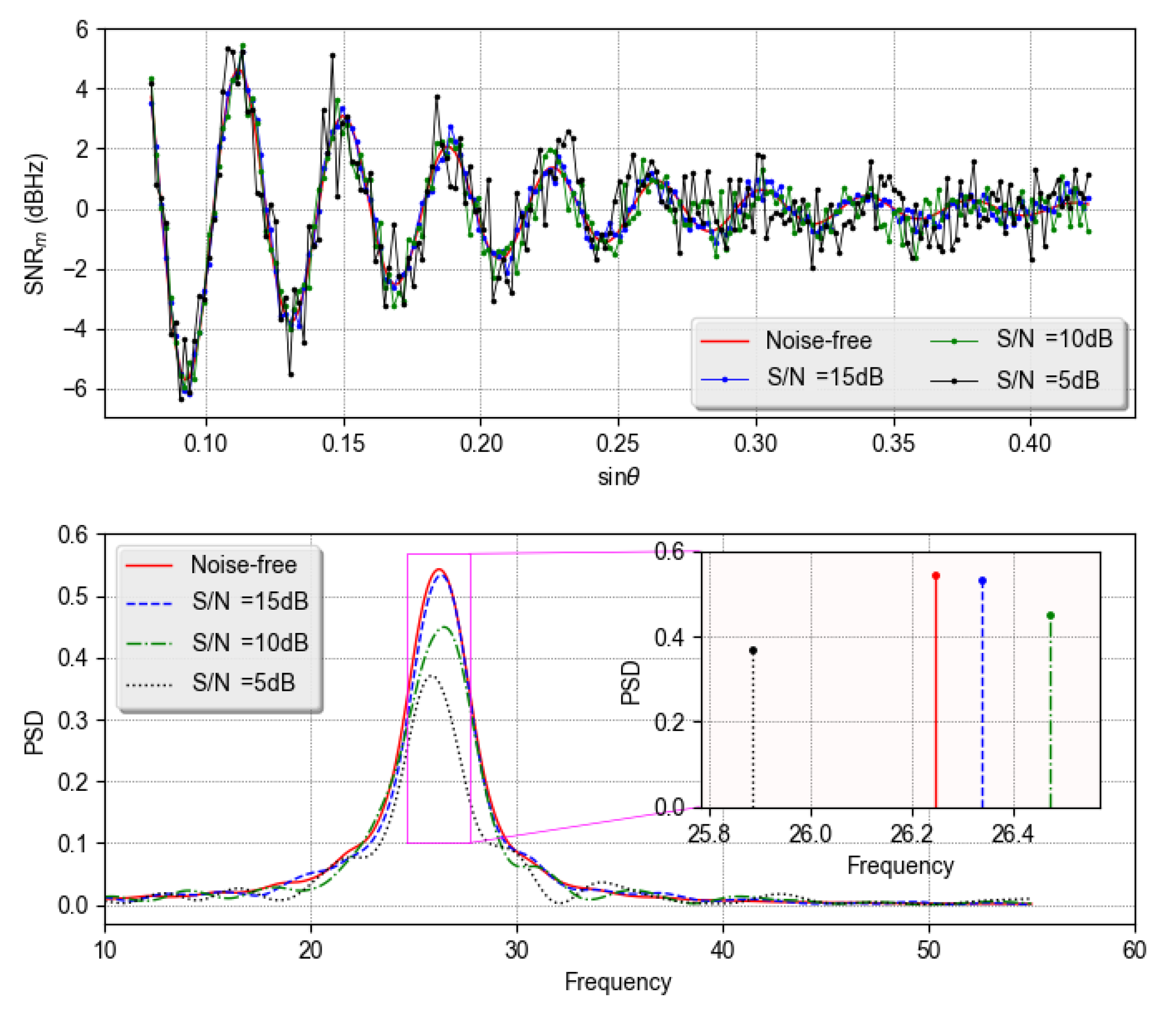
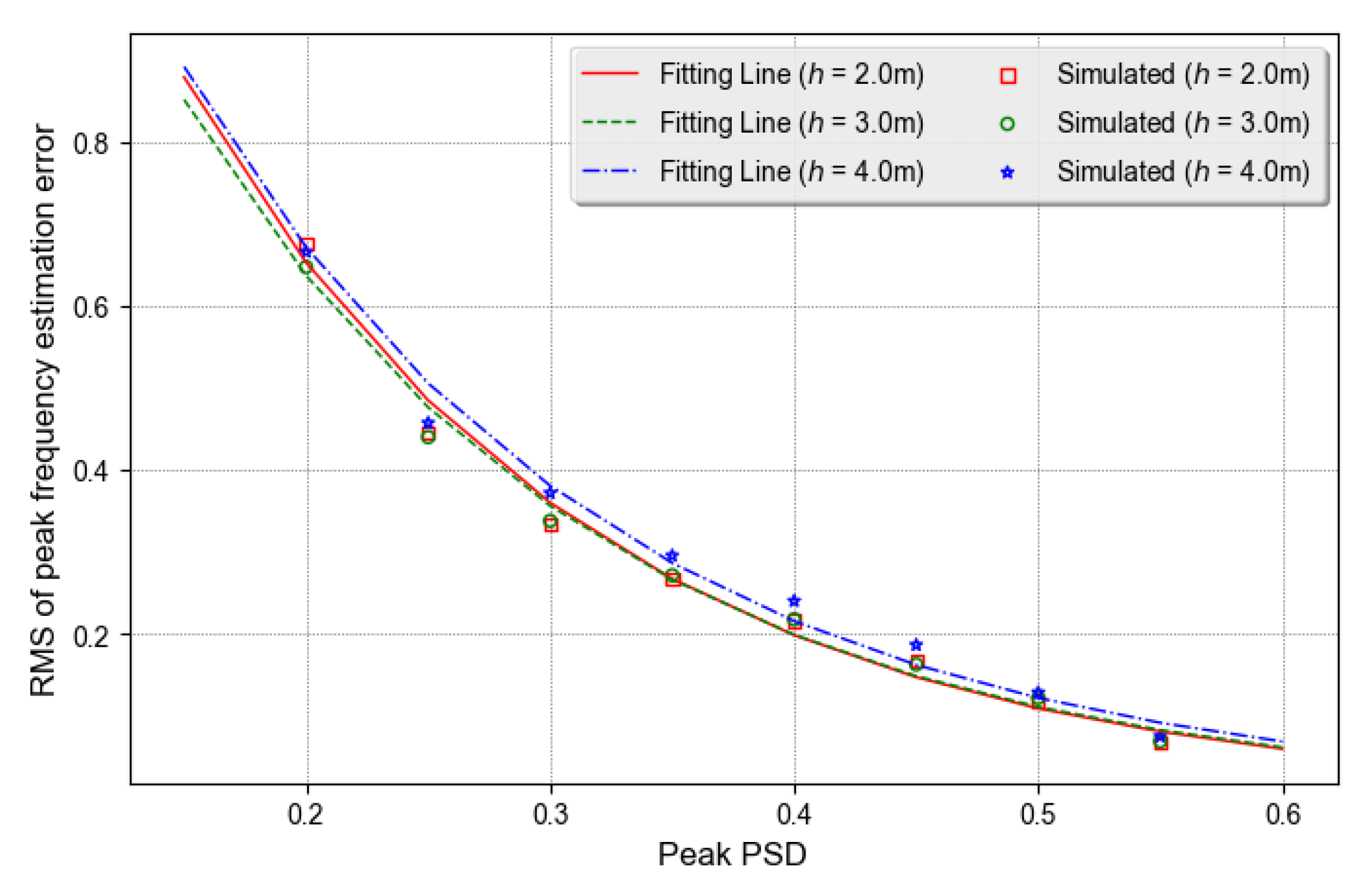
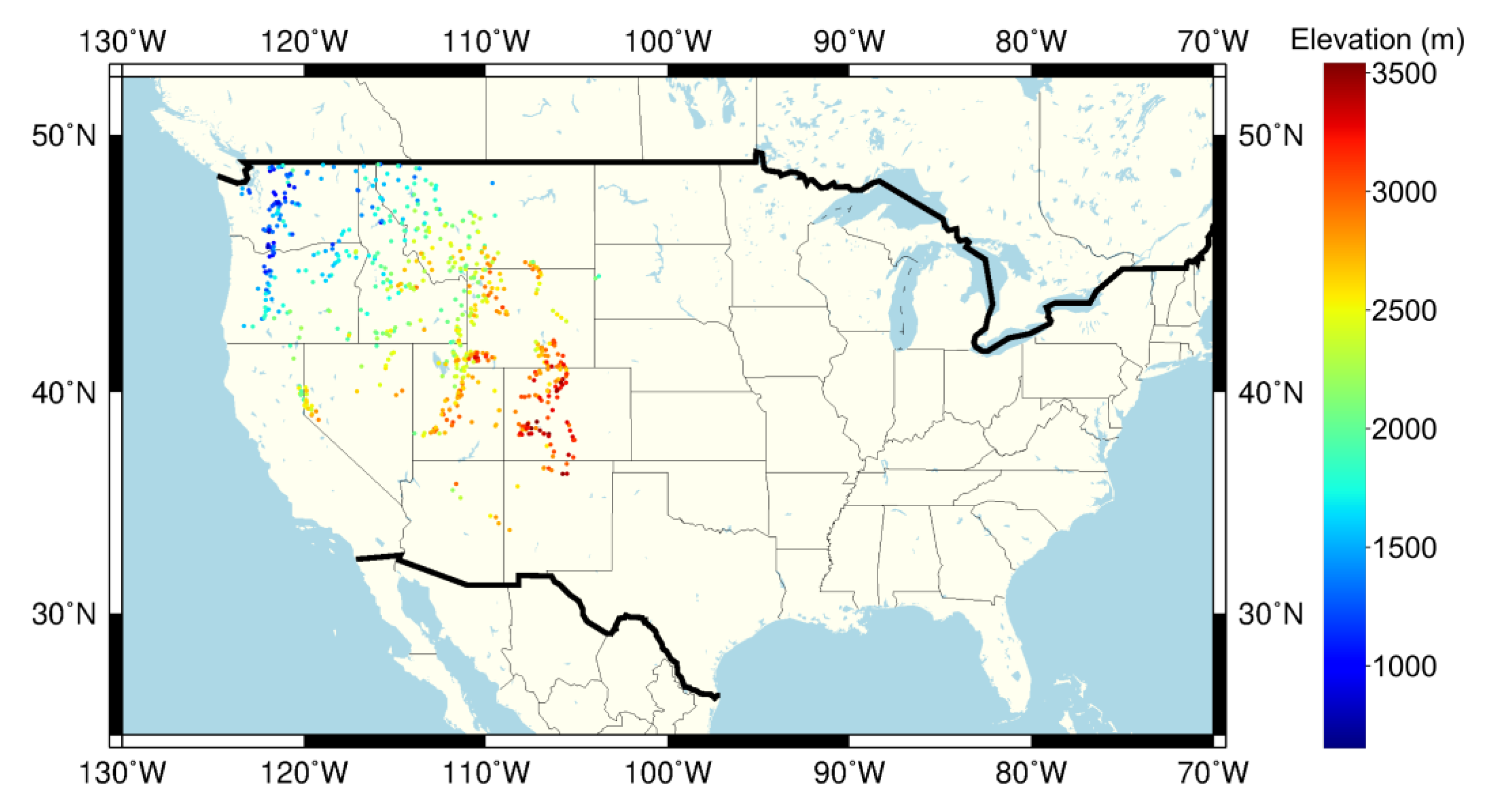
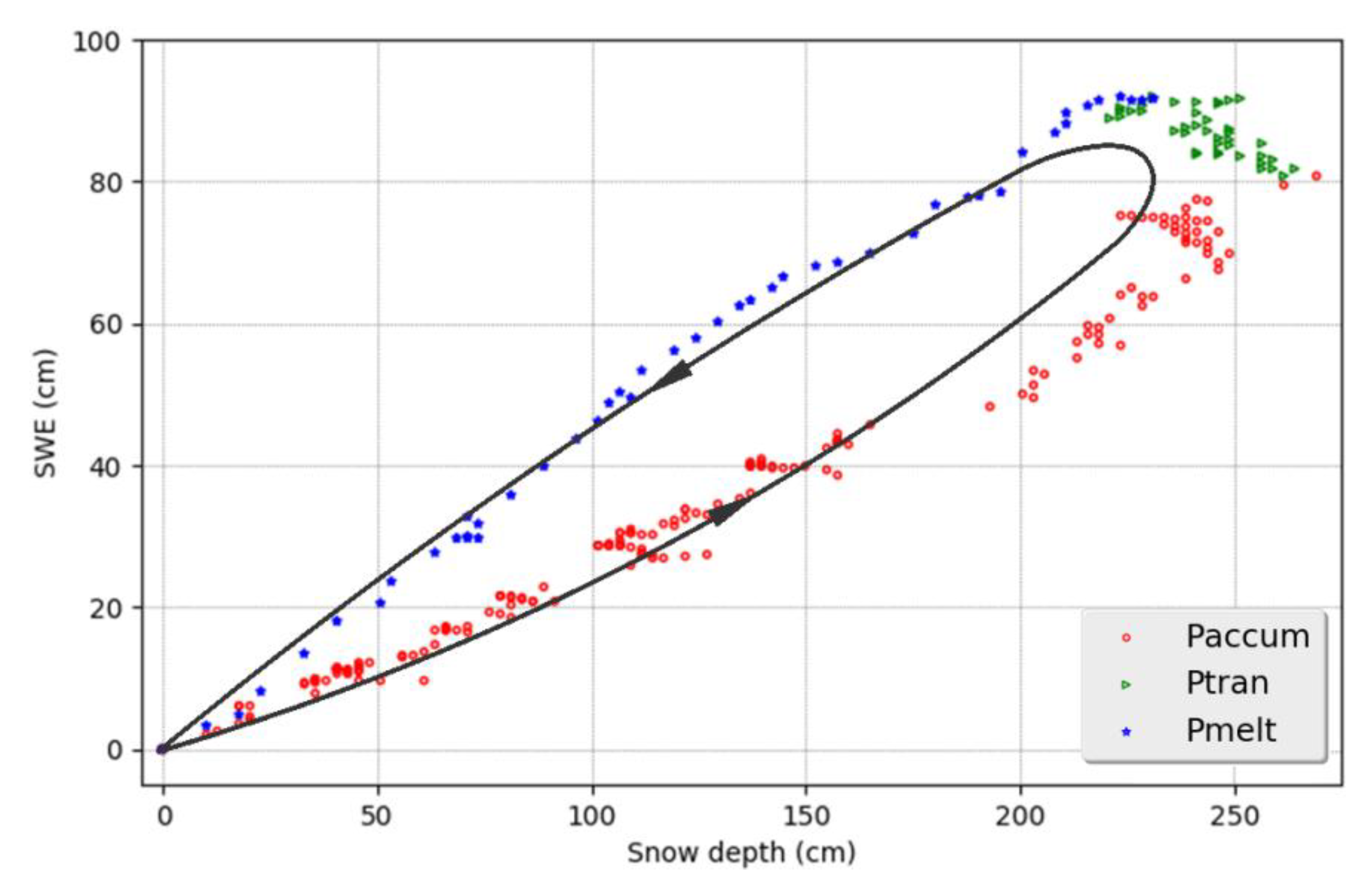
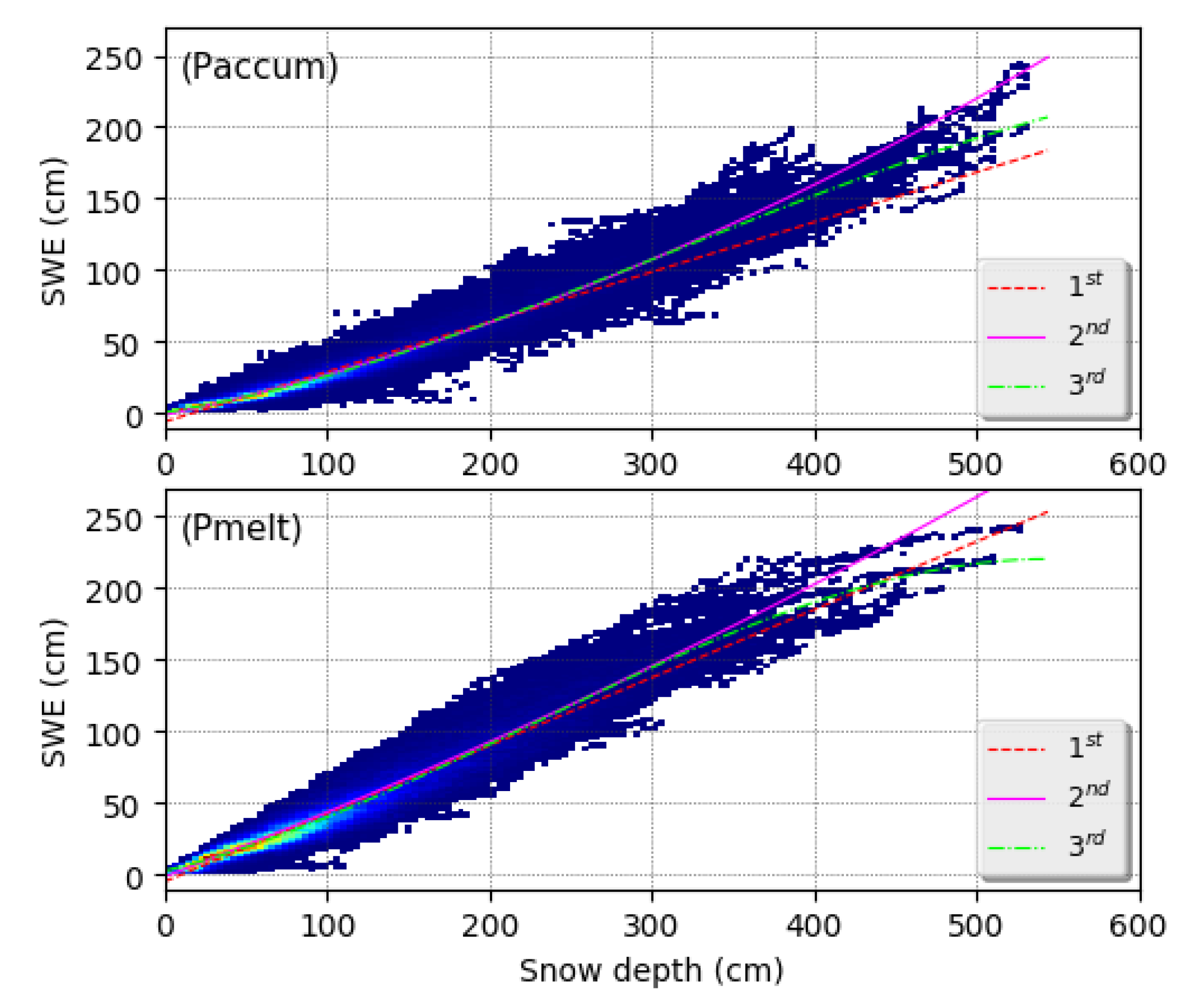
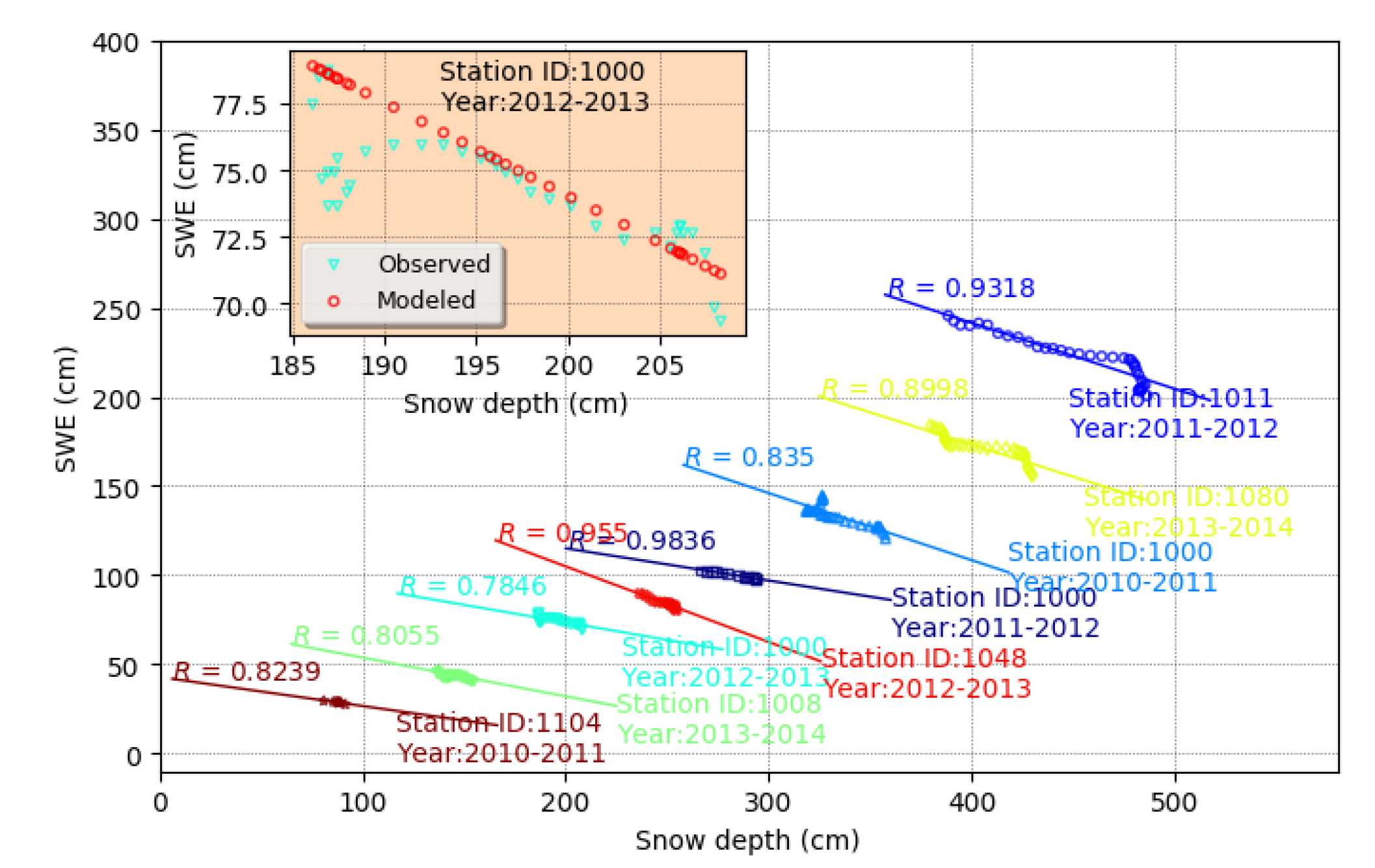
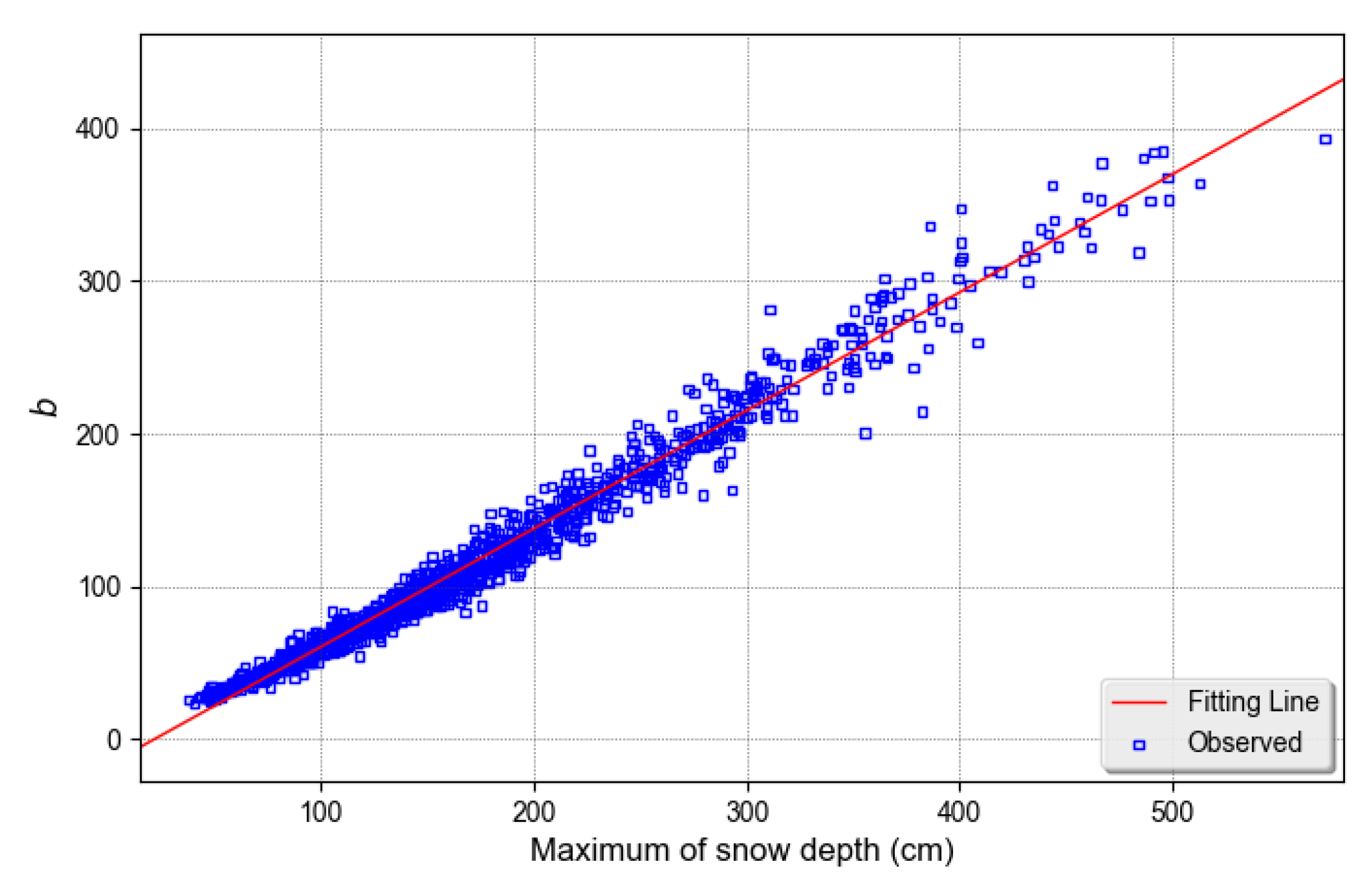
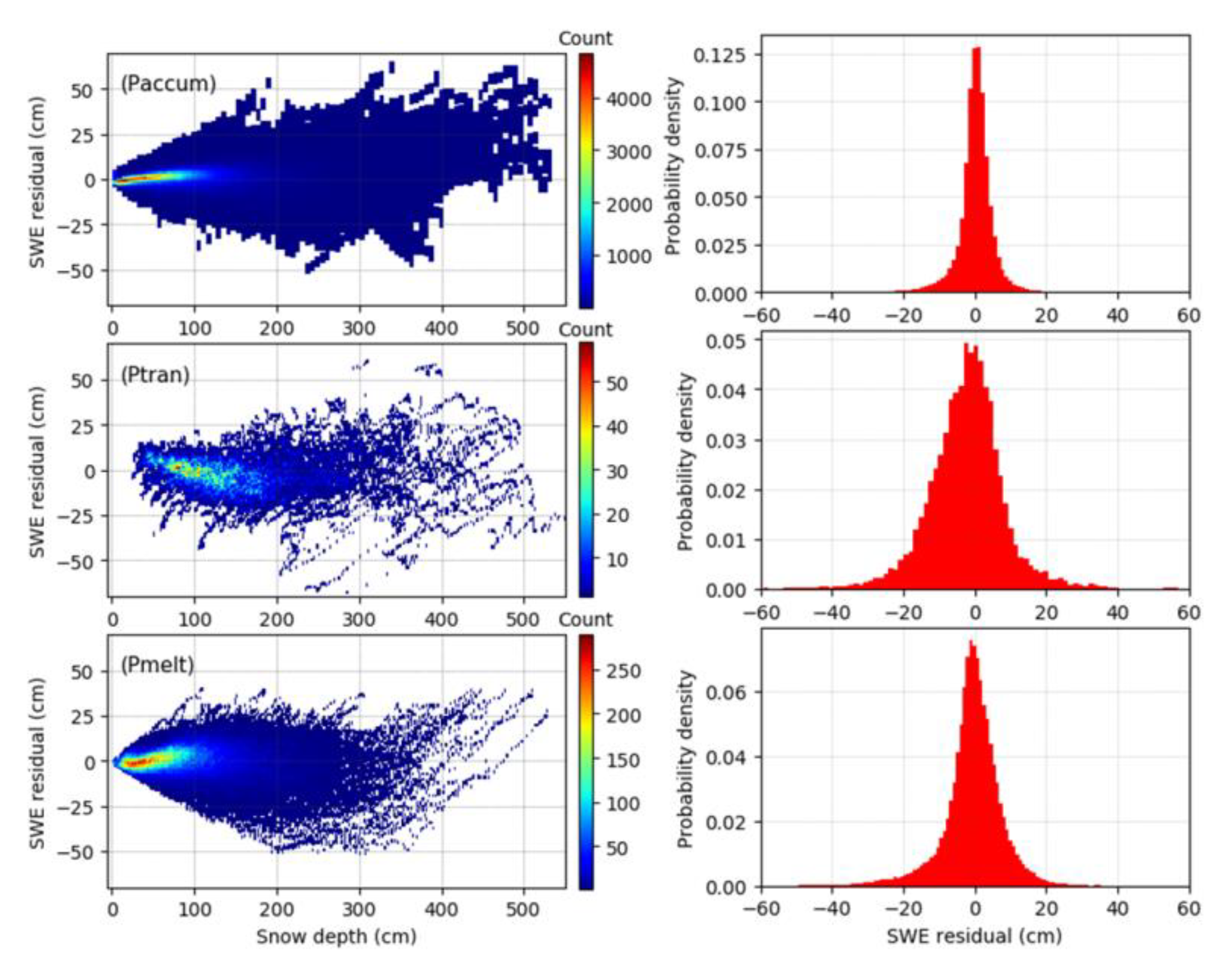
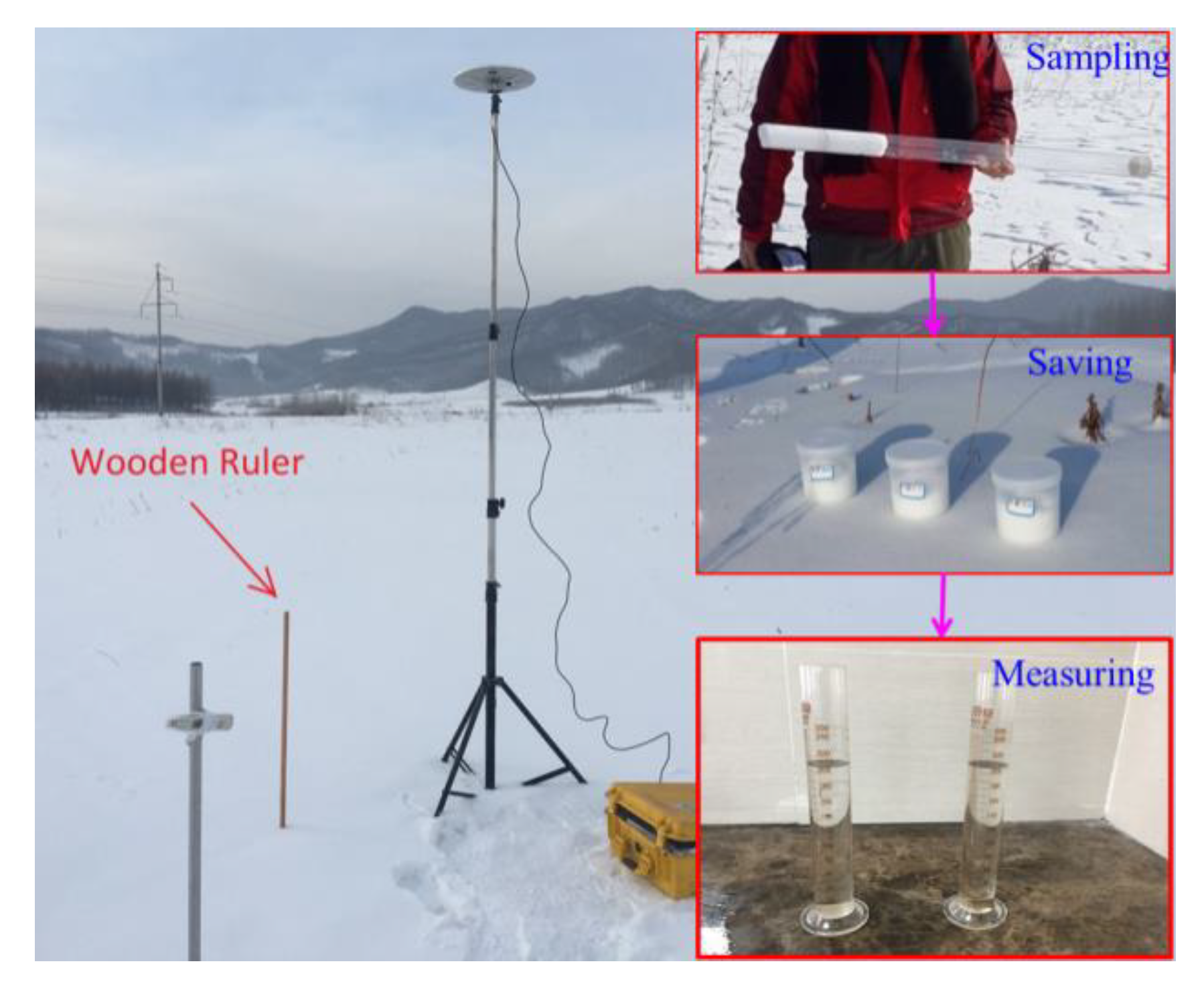
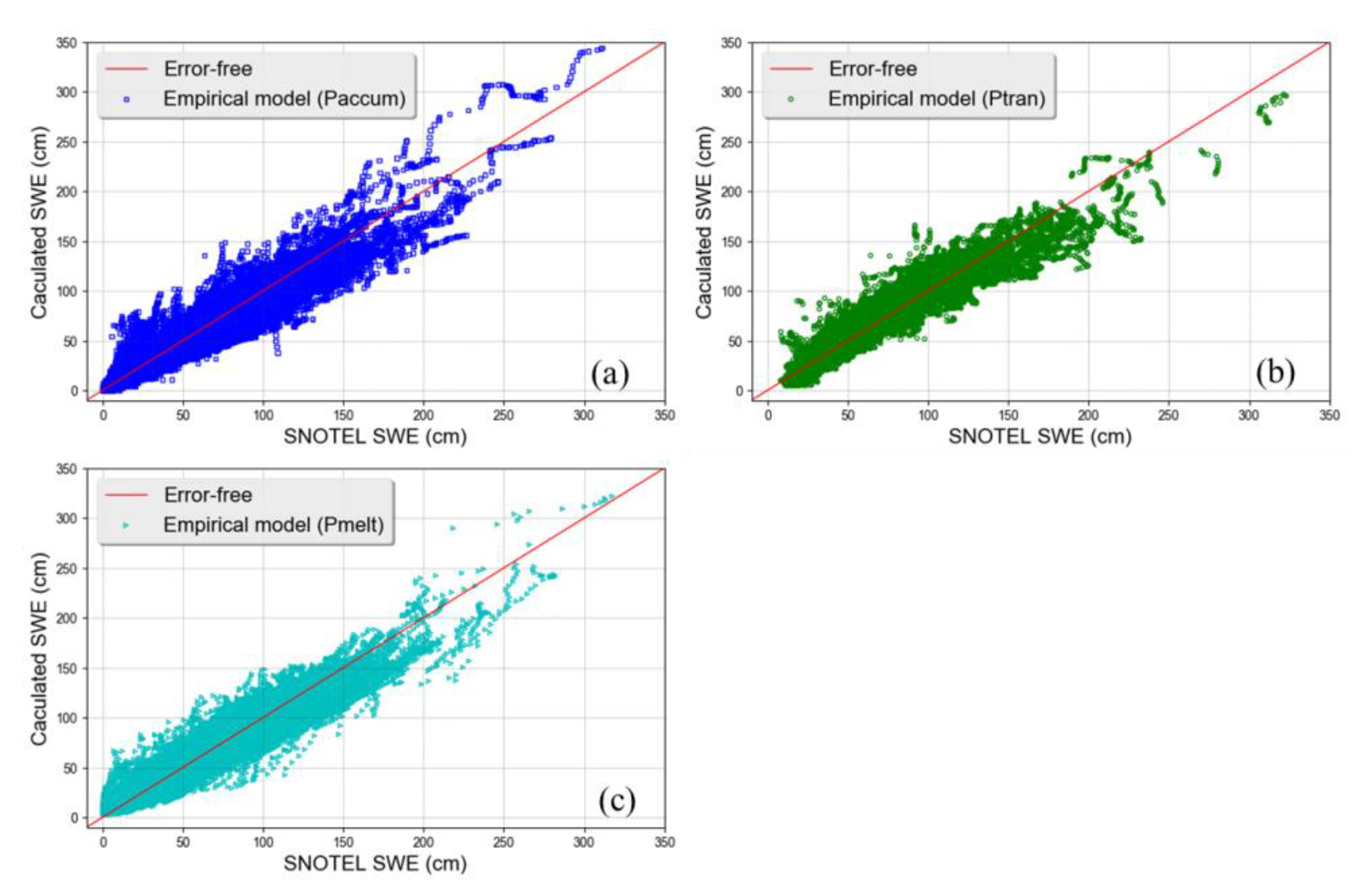
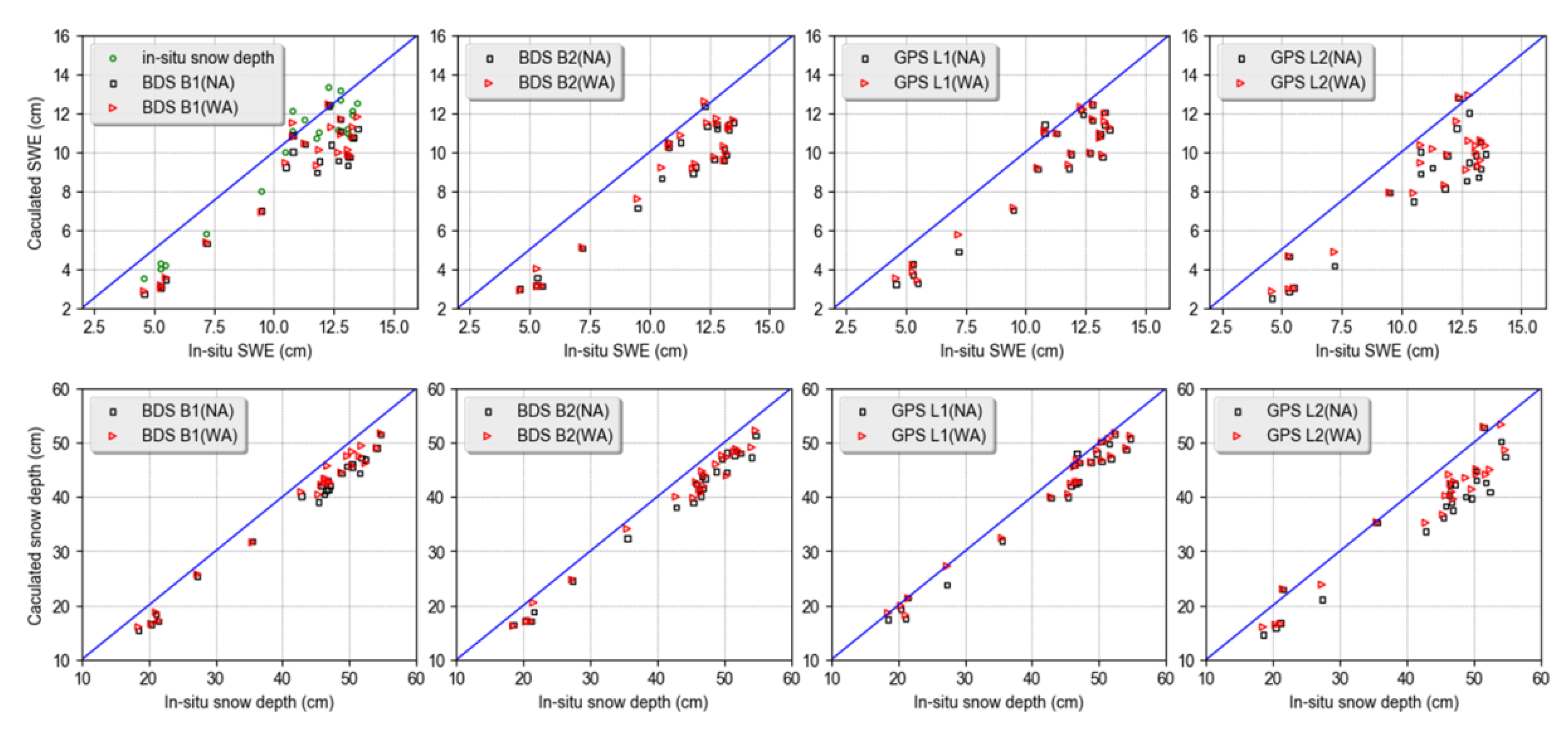
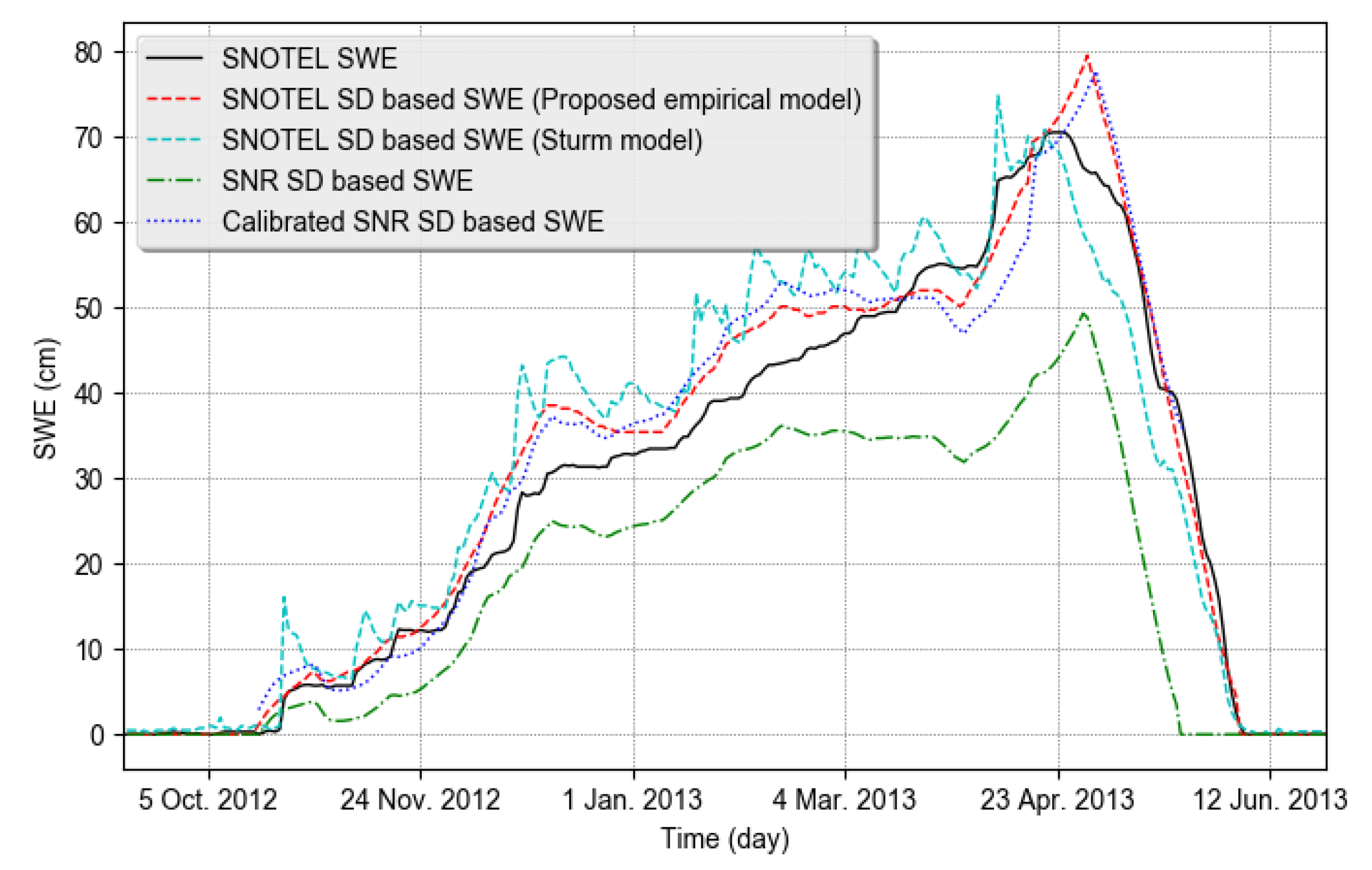
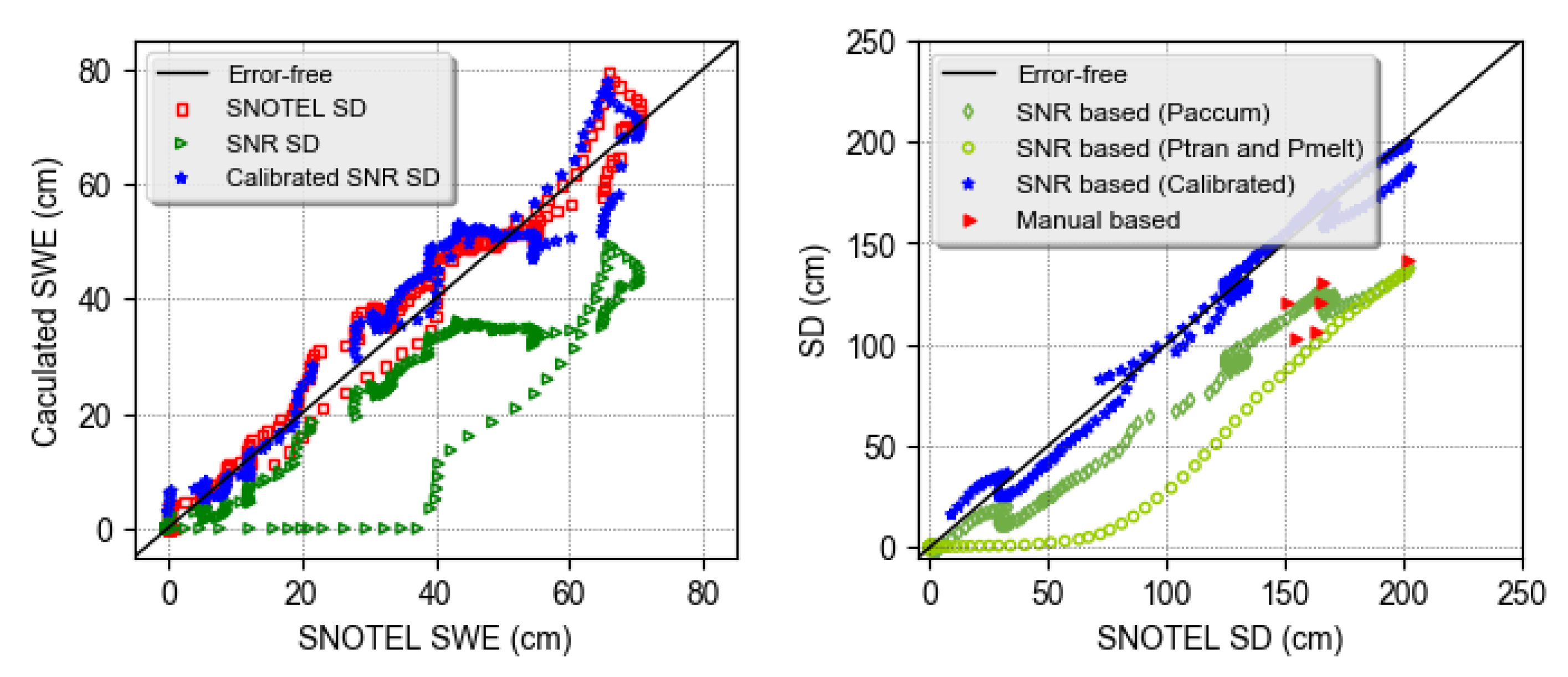
| Antenna Height (m) | α | β | R |
|---|---|---|---|
| 1.0 | 2.12 | −5.79 | 0.9886 |
| 1.5 | 2.06 | −5.43 | 0.9840 |
| 2.0 | 2.14 | −5.94 | 0.9903 |
| 2.5 | 1.91 | −5.05 | 0.9807 |
| 3.0 | 2.03 | −5.80 | 0.9907 |
| 3.5 | 1.99 | −5.34 | 0.9864 |
| 4.0 | 2.08 | −5.67 | 0.9877 |
| 4.5 | 2.16 | −5.67 | 0.9887 |
| 5.0 | 2.06 | −5.47 | 0.9849 |
| Phase | Polynomials | Fitting Polynomial Coefficients | R | |||
|---|---|---|---|---|---|---|
| 3rd | 2nd | 1st | c | |||
| Paccum | 1st | - | - | 0.3484 | −5.8202 | 0.9696 |
| 2nd | - | 0.0004 | 0.2417 | −1.1102 | 0.9775 | |
| 3rd | −0.92 × 10−6 | 8.7 × 10−4 | 0.1761 | 0.7331 | 0.9784 | |
| Pmelt | 1st | - | - | 0.4748 | −4.9221 | 0.9679 |
| 2nd | - | 0.0002 | 0.4301 | −1.478 | 0.9695 | |
| 3rd | −1.78 × 10−6 | 1.2 × 10−4 | 0.2719 | 2.6027 | 0.9709 | |
| Phase | Polynomials | Fitting Error | ||
|---|---|---|---|---|
| Mean (cm) | STD (cm) | RMSE (cm) | ||
| Paccum | 1st | 0.00 | 5.93 | 5.93 |
| 2nd | 0.27 | 5.12 | 5.13 | |
| 3rd | −0.01 | 5.01 | 5.01 | |
| Pmelt | 1st | 0.00 | 8.39 | 8.39 |
| 2nd | −0.64 | 8.24 | 8.27 | |
| 3rd | 0.00 | 7.99 | 7.99 | |
| Period | Mean (cm) | STD (cm) | RMS (cm) |
|---|---|---|---|
| Paccum | −0.20 | 5.76 | 5.77 |
| Ptran | −1.27 | 9.40 | 9.48 |
| Pmelt | −0.07 | 8.12 | 8.13 |
| Band | Method | Mean (cm) | STD (cm) | RMS (cm) |
|---|---|---|---|---|
| -- | Ruler | −0.82 | 0.98 | 1.28 |
| BDS B1 | NA | −2.03 | 1.02 | 2.28 |
| WA | −1.76 | 1.05 | 2.05 | |
| BDS B2 | NA | −1.93 | 0.95 | 2.15 |
| WA | −1.77 | 0.99 | 2.03 | |
| GPS L1 | NA | −1.52 | 1.05 | 1.85 |
| WA | −1.41 | 1.01 | 1.73 | |
| GPS L2 | NA | −2.47 | 1.30 | 2.79 |
| WA | −2.07 | 1.24 | 2.42 |
| Method | Mean (cm) | STD (cm) | RMSE (cm) |
|---|---|---|---|
| SNOTEL SD | 1.53 | 3.23 | 3.58 |
| SNR SD | −10.26 | 9.50 | 13.98 |
| Calibrated SNR SD | 1.98 | 4.92 | 5.31 |
Publisher’s Note: MDPI stays neutral with regard to jurisdictional claims in published maps and institutional affiliations. |
© 2020 by the authors. Licensee MDPI, Basel, Switzerland. This article is an open access article distributed under the terms and conditions of the Creative Commons Attribution (CC BY) license (http://creativecommons.org/licenses/by/4.0/).
Share and Cite
Yu, K.; Li, Y.; Jin, T.; Chang, X.; Wang, Q.; Li, J. GNSS-R-Based Snow Water Equivalent Estimation with Empirical Modeling and Enhanced SNR-Based Snow Depth Estimation. Remote Sens. 2020, 12, 3905. https://doi.org/10.3390/rs12233905
Yu K, Li Y, Jin T, Chang X, Wang Q, Li J. GNSS-R-Based Snow Water Equivalent Estimation with Empirical Modeling and Enhanced SNR-Based Snow Depth Estimation. Remote Sensing. 2020; 12(23):3905. https://doi.org/10.3390/rs12233905
Chicago/Turabian StyleYu, Kegen, Yunwei Li, Taoyong Jin, Xin Chang, Qi Wang, and Jiancheng Li. 2020. "GNSS-R-Based Snow Water Equivalent Estimation with Empirical Modeling and Enhanced SNR-Based Snow Depth Estimation" Remote Sensing 12, no. 23: 3905. https://doi.org/10.3390/rs12233905
APA StyleYu, K., Li, Y., Jin, T., Chang, X., Wang, Q., & Li, J. (2020). GNSS-R-Based Snow Water Equivalent Estimation with Empirical Modeling and Enhanced SNR-Based Snow Depth Estimation. Remote Sensing, 12(23), 3905. https://doi.org/10.3390/rs12233905







